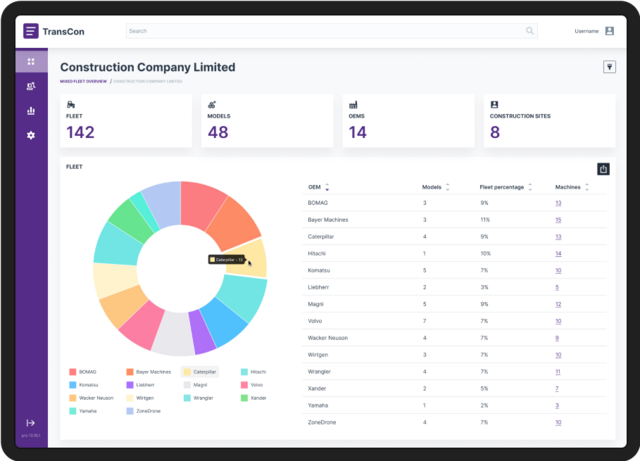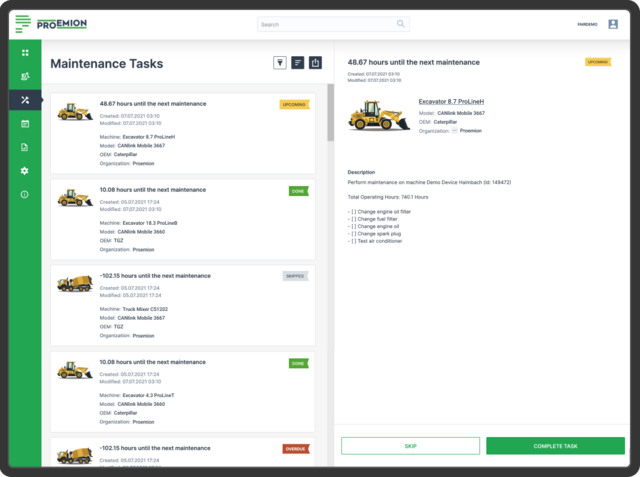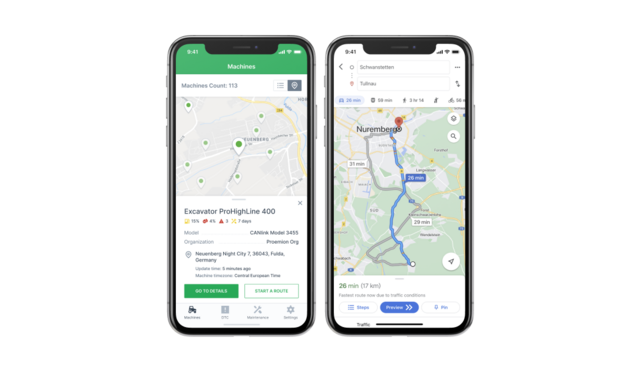7 benefits of having a unified telematics solution for Mixed Fleets
Executive Summary
Implementing a unified telematics solution for your mixed fleet machines and equipment meant you no longer had to check multiple portals to extract, interpret, and exploit data.
In addition to the operational benefits delivered by a unified view of your various machines and equipment, there were substantial business benefits to be gained.
In this white paper, we explored 7 of these benefits under the following headings:
- Data Harmonization
- Reduced operational cost through proper maintenance
- Optimal machine idling
- Increased productivity
- Improved cash flow
- Optimal fuel management
- Machine use optimization
We concluded that a unified telematics solution for your mixed fleet machines and equipment resulted in reduced operational cost, increased productivity, improved cash flow, and many other business benefits.
The work needed was not hard, and once a unified telematics solution was in place, you could expect to reap the rewards within as little as 3 months.
Introduction
A unified telematics connectivity solution for off-highway machines can securely capture and transmit telematics data from a mixed fleet, delivering tangible benefits to dealers, equipment owners, and rental companies.
An integrated mixed fleet telematics solution delivers insightful data from all your machines to help you implement your IoT strategies and set your business up for success in the age of digital transformation.
Telematics solves most issues organizations maintaining paper-based processes face. However, it creates new challenges for businesses that operate a mixed branded fleet of machines as OEM telematics don't integrate with each other.
The amount of work to integrate different telematics and the lack of interoperability between OEM telematics systems was recognized by the Association of Equipment Management Professionals (AEMP) - an organization serving those who manage and maintain heavy off-road fleets as well as equipment in general.
Focusing on facilitating data integration from multiple telematics portals, they developed a standard that specifies "the communication schema to provide mobile machinery status data from a telematics provider's server to third-party client applications via the Internet." This standard, originally known as ISO 15143-3, is also described as AEMP 2.0.
The right unified solution is cost-effective as you can re-use existing IoT and telematics assets, without buying additional hardware.
This white paper explores the wide range of business benefits of a unified telematics solution for a mixed fleet.
The benefits of introducing a unified telematics solution
Introducing a unified telematics solution for your mixed fleet machines delivers real benefits to your organization quickly – in less than 3 months.
But what competitive advantages can you gain from such a solution, what problems does the solution solve and mitigate, and what effect can you expect to see on your bottom line?
Let’s explore these and other relevant questions further.
Using a variety of data platforms from different manufacturers means reduced efficiency. Coordinating all this disparate information, interpreting it in a useful way, and delivering value to the business is a serious challenge. In addition, parallel platforms for small device trackers and vehicles introduce inefficiencies; maintaining multiple interfaces is costly and can be prone to failure as a result.
The usability of OEM platforms also varies widely - a single, simple user interface dramatically improves ease of use.
Fully integrating all data sources on a single platform means:
- All equipment, including machines, small equipment, and trucks, provide data on a single multi-brand platform.
- The consolidated platform can be integrated with other systems, such as your ERP (Enterprise Resource Planning) system, consistently.
- Continuous monitoring of the data supplied by the OEM to ensure quality and raise alerts in case of lack of quality.
- A reduction in the coordination effort previously needed across multiple interfaces as there is no need to build and maintain custom integrations with proprietary vendor interfaces.
- Long-term availability and access to historical data. Even if the interface with a provider fails.

It’s no secret that regular maintenance extends the longevity of your machines. Maintenance dashboards help your team of experts track the maintenance needs of each machine, making overdue maintenance a thing of the past.

Tracking work orders, providing evidence of work done, and maintenance planning using a manual, paper-based system is cumbersome and inefficient.
Forward-thinking companies have automated the creation of work orders (assignments) in their service ticketing systems, thereby reducing manual steps in their processes. Assignments are focused on creating work orders for a machine or set of machines and providing evidence of the work done.
Automation means data accuracy across business processes is increased and errors reduced. Additionally, compliance becomes more automated, efficiency increases, and organizations move ever closer to a paperless system with its associated cost savings.
Maintenance planning that relies on manually entered data presents several challenges, including compliance with service intervals. Without a unified view of equipment, transmission errors and incomplete data result in missed maintenance and unplanned downtime. With all service intervals coordinated through a single, centralized dashboard, you'll never miss one again.
A poorly documented process means multiple machine trips for upgrades and maintenance and wasted time spent on-site searching for machines to be maintained.
An automated (or even partially automated) machine maintenance process has the following benefits:
- More automation means the process is more accurate, better planned and you can organize your staffing (service technicians) more efficiently based on location, availability, and workload.
- All maintenance is centrally managed regardless of the asset type and OEM.
- Maintenance organization and work assignment planning are automated.
- You always have up-to-date information on your machines' locations, to better organize maintenance work.
- Work orders are automatically transferred to the order management of the maintenance department and to order documentation.
- Errors are prevented, and maintenance planning is optimized.
- By doing proper maintenance, machine downtime is lowered.
Based on telematics data collected, the average idle time for construction machines ranges between 30-40%. While some conditions mandate machine idling, it goes beyond burning fuel without accomplishing any work.
Many new machines use up the hour-terms of their warranties just idling and never have the chance to fail under load. If the maintenance program is based on hours of utilization, then the owner incurs unnecessary preventive maintenance costs.
Extended idling increases your machines' hour-meter readings. This can negatively influence the evaluation of the equipment when it is traded for new equipment, sold privately, or taken to auction. Machine idling without doing effective work means you're throwing money away.
However, machine idling doesn't always mean a machine isn't productive, and striving for the lowest percentage possible may be impractical.
Heavy equipment manufacturers ask their customers to consider idling thoughtfully and encourage its minimization.
Efficiency dashboards help construction companies manage to idle more effectively. For example, fleet managers can drill down to the individual machine level and determine whether the amount of idling is justified or not.
Depending on the size of your construction sites, locating equipment can become a daunting task, especially when it's dark. However, with integration to Google Maps (for example), mobile apps can easily navigate you to any machine on your site and avoid wasted runs.
Having all your machines' location data available in a single dashboard also means you don't waste time calling job sites. Instead, you can dispatch the right equipment from the closest location, saving fuel, time, and money.

Processing paper-based timesheets may take weeks, preventing your company from issuing invoices. You can automatically assign machines to a specific construction site and collect the relevant machine data using the machine's GPS position and identification details. Your data quality increases, and since machine data is now readily available, you can issue your invoices faster, improving your cash flow.
More specifically, a rental company can issue invoices to clients faster, and equipment owners can use the information to allocate machine use costs to cost centers or projects more efficiently.
Rental companies can also offer new pricing based on the actual operating hours of the machine to be more transparent in their cost structure.
With automation in place, you now rely less on manual input and the high costs of the staff required to process physical paperwork.
In large fleets, coordinated fuel management can help you plan fuel purchases at a higher volume and negotiate better prices as a result. In addition, managing your fleet closer allows you to be more efficient when purchasing just what you need, and ultimately you prevent machine downtime due to lack of fuel on-site.
An uncoordinated fuel call-off process between your construction site (foreman, machine operator) and your fuel supplier leads to a poorly managed, clumsy process. And it can result in refueling and restarting the wrong machines, bad timing, lost productivity, and extended standstill times due to fuel supply interruptions.
Delivery notes and invoices can become mismatched due to an inefficient process.
An automated (or even partially automated) refueling management process has the following benefits across your fleet:
- Machines report refueling needs directly to dispatch and the fuel supplier.
- The position of your machines is also sent, reducing time spent searching for your machines on site.
- The correct fuel requirement is reported, relative to the fill level, the threshold level, and the predicted consumption.
- The fuel supplier reports refueling digitally via electronic invoice, and a comparison is made between the quantity of fuel supplied and the fill level.
- Inefficient fueling that's not in line with demand is eliminated.
- An efficient digital workflow that covers orders and delivers billing and invoices are created.
A unified telematics solution for a mixed fleet increases your fleet’s overall utilization by allocating the right machine to the right job site.
You need to understand which machines are in use or available and where they’re located.
Without an optimized scheduling process, technical capacity utilization is difficult to assess. Also, an unoptimized process results in requirement reporting and machine scheduling based on subjective criteria.
Assessment for capacity utilization optimization usually relies only on commercial capacity utilization measures. Construction sites can’t optimize their processes with reliable machine data.
Lack of location data leads to extended search times for machines to be transported.
Finally, hours are usually only recorded for maintenance and repair work, making it challenging to use data for scheduling, controlling, billing, etc.
An optimized scheduling process means:
- Dispatchers access accurate data (operating hours, geo-positioning, and fill levels).
- Machine conveyors can find machines immediately thanks to digital order control.
- Communication between all parties is based on real, accurate data.
- Machine invoicing is more accurate and accounts for technical utilization.
- Communication times in the scheduling process are reduced. Errors are prevented by using accurate data
Conclusion
A unified telematics solution for your mixed fleet machines and equipment results in real benefits, such as reduced operational cost, increased productivity, and improved cash flow.
Moreover, the lack of such a solution in your business puts increased pressure on your team to deliver results without the right tools to help them do so.
The work that needs to be done to transform your business is not hard, and once you begin the process, you’ll realize substantial beneficial business outcomes in as little as 3 months!
Stop wasting time and money.

